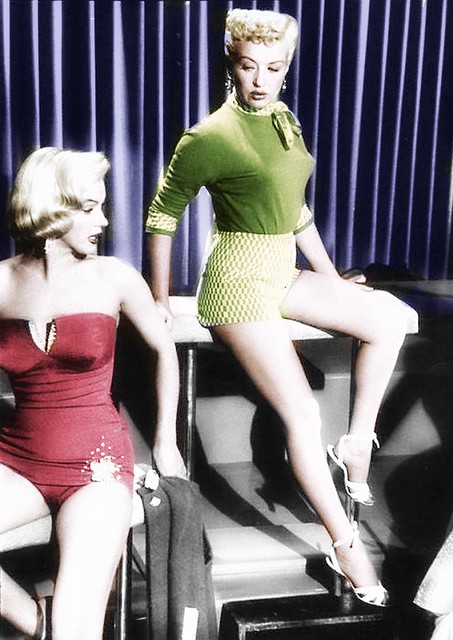In 1953, at the height of Hollywood’s golden age, a single photograph captured something timeless: two of cinema’s most radiant stars—Betty Grable and Marilyn Monroe—standing side by side on the set of How to Marry a Millionaire. More than just a behind-the-scenes moment, the image symbolized the convergence of two generations of screen legends, each with her own brand of allure, grace, and cinematic power.

Betty Grable, already a beloved icon and the definitive World War II pin-up girl, radiated polished sophistication. She had built her reputation in musicals and comedies, known for her charisma and the famed “million-dollar legs” that made her a household name. By contrast, Marilyn Monroe was on the rise. With her breathy voice, glowing presence, and magnetic sensuality, Monroe embodied a new era of Hollywood femininity—bolder, more playful, and undeniably captivating.

How to Marry a Millionaire offered both women the chance to shine, and shine they did. For Monroe, the film became a crucial stepping stone, helping to cement her status as a leading lady. She used the opportunity to prove she was more than just a pretty face—her timing, charm, and vulnerability in comedic scenes revealed the layered talent beneath the surface. Meanwhile, Grable’s performance reminded audiences why she had long held the public’s affection, balancing glamour with a mature, knowing wit.

Despite the industry’s tendency to pit female stars against one another, Grable and Monroe shared a mutual respect that was evident both on and off screen. Grable reportedly told Monroe, “Go and get yours, honey! I’ve had mine,” signaling not rivalry, but recognition. The collaboration marked a rare moment of solidarity between two screen sirens at very different points in their careers.

The iconic photo taken during the production has become a lasting emblem of 1950s Hollywood—when elegance and star power reigned, and when actresses like Grable and Monroe shaped not only the silver screen but the cultural imagination. Their portrayal of women seeking love, wealth, and independence—albeit through comedy and fantasy—reflected a deeper undercurrent of ambition and agency in an era just beginning to question traditional roles.

Decades later, Betty Grable and Marilyn Monroe are remembered not just for their beauty or fame, but for their unique contributions to film history. Their shared moment in How to Marry a Millionaire remains a glittering chapter in Hollywood lore: a brief intersection of past and future, captured forever in a single frame.